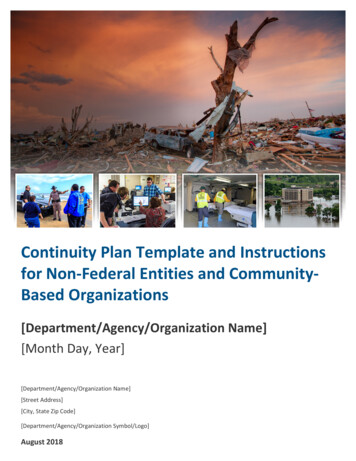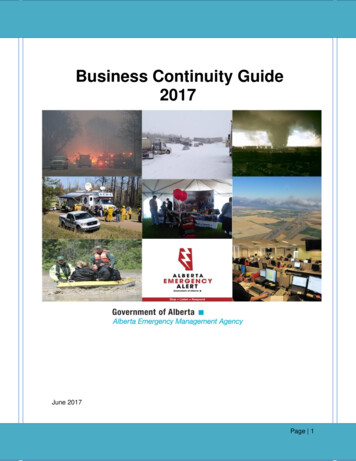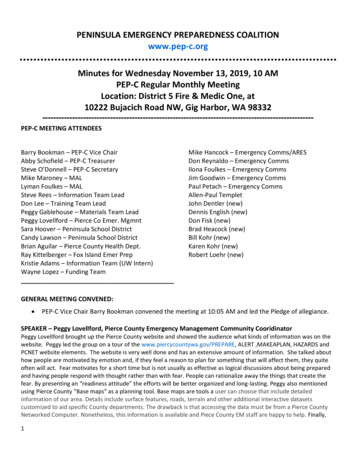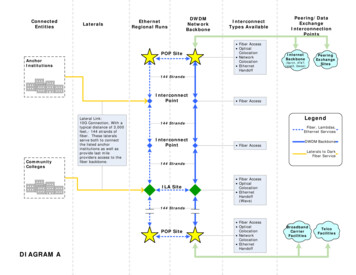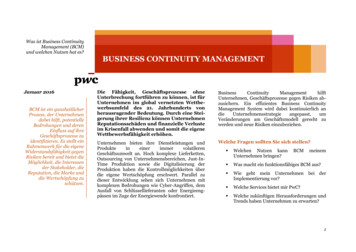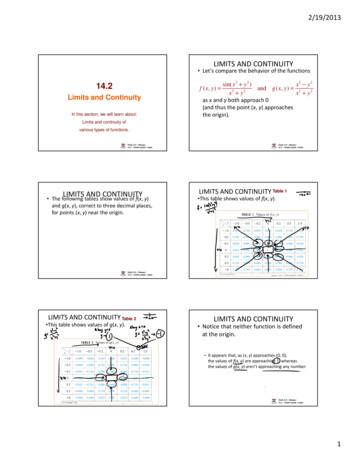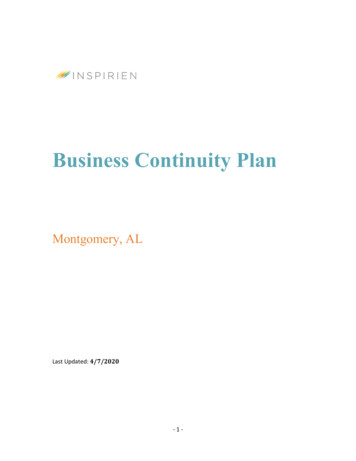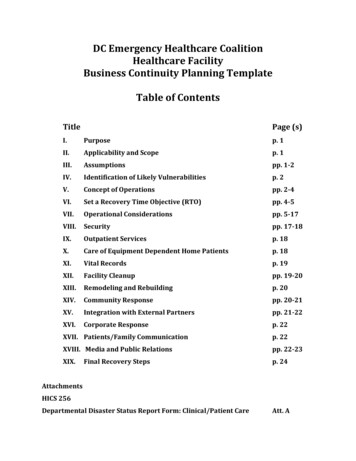
Transcription
DC Emergency Healthcare CoalitionHealthcare FacilityBusiness Continuity Planning TemplateTable of ContentsTitlePage (s)I.Purposep. 1II.Applicability and Scopep. 1III.Assumptionspp. 1-2IV.Identification of Likely Vulnerabilitiesp. 2V.Concept of Operationspp. 2-4VI.Set a Recovery Time Objective (RTO)pp. 4-5VII.Operational Considerationspp. 5-17VIII.Securitypp. 17-18IX.Outpatient Servicesp. 18X.Care of Equipment Dependent Home Patientsp. 18XI.Vital Recordsp. 19XII.Facility Cleanuppp. 19-20XIII.Remodeling and Rebuildingp. 20XIV.Community Responsepp. 20-21XV.Integration with External Partnerspp. 21-22XVI.Corporate Responsep. 22XVII. Patients/Family Communicationp. 22XVIII. Media and Public Relationspp. 22-23XIX.p. 24Final Recovery StepsAttachmentsHICS 256Departmental Disaster Status Report Form: Clinical/Patient CareAtt. A
Downtime Departmental Disaster Status Report Form:Att. BNon-Clinical/Office EnvironmentRisk Assessment MatrixAtt. CInventory & Sustainability Resources & Assets TableAtt. DSelected Fed’l Legal Authorities Pertinent to Public Health Emergencies Att. 1Healthcare Primary Mission Essential Function (PMEF) and MissionEssential Functions (MEF’s)Att. 2
DC Emergency Healthcare CoalitionHealthcare FacilityBusiness Continuity Planning TemplateI.PurposeTo provide guidance for those in charge on how to ensure essentialbusiness functions are continued in the event a disaster or otheruntoward incident disrupts normal business operations.II.III.Applicability and ScopeA. This plan shall be used to assist those in charge of the facilityconfronting one of the following situations:1. Operational and able to provide all normal operations but facedwith structural damage and/ or staff reductions and /or limitedavailable leadership.2. Partially operational – able to provide some but not all of thenormal services.3. Closed and attempting to reopen - the situation is beingaddressed and steps are being taken to reopen and resume fulloperations whether all at once or in staged manner.B. The plan is also intended to assist this facility identify and prioritizethe essential functions to be continued. The prioritization might bedone1. By each department by those in charge of the department orsomeone else assigned the responsibility2. For the whole facility by those in chargeAuthorityA. Federal Legal Authorities See Attachment 1 – Selected Federal Legal Authorities Pertinentto Public Health Emergencies (CDC - 2/2104 ) for current listingB.City Authority Information PENDING FROM HSEMA5/1/2-20141
IV.V.Healthcare Primary Mission Essential Function (PMEF) and MissionEssential Functions (MEFs)A. To clarify business continuity and recovery planning and responseroles and responsibilities for DC Department of Health, the DCEmergency Healthcare Coalition and each Healthcare OrganizationAttachment 2 addresses the following situations:1. Healthcare Service Delivery for inpatient and outpatientenvironments2. Access to Health Work Force – ability to deploy a credentialedhealth workforce to provide patient care to support healthcareservice delivery in all environments3. Community/Facility Critical Infrastructure – Fullyoperational critical community /facility infrastructure includingpower, water, and sanitation etc., to support patient careenvironments4. Access to Healthcare Supply Chain – Full access to thehealthcare supply chain including medical and non-medicalsupplies, pharmaceuticals, blood products, industrial fuels andmedical gases etc.5. Access to Medical /Non-Medical Transportation System –Fully functional medical and non-medical transportation systemthat can meet the operational needs of the healthcare sectorduring the response & continuity phases of an event.6. Information Technology/Communications – Fully functionalinformation technology and communications infrastructure thatsupport high availability of the healthcare sectors datamanagement and information sharing capability.7. Healthcare Administration /Finance – Fully operationaladministrative and financial capability including maintainingand updating patient records, adapting to disaster recoveryprogram requirements, payroll continuity, supply chainfinancing, claims submission, losses covered by insurance andlegal issues.AssumptionsA. During a crisis every healthcare facility will have a need for abusiness continuity planB. The availability of this plan will assist the facility to:5/1/2-20142
1.C.D.E.F.VI.VII.Continue its principle mission of providing patient care despitethe impact a disaster or untoward incident may have on thefacility and /or its operations.2. Fulfill legal, moral and ethical responsibilities to its patients,staff, and the community.3. Comply with pertinent District of Columbia and federalregulations regarding maintaining and/or restoring businessoperations in a timely manner.4. Minimize the loss of market share, financial losses and /or fines.5. Reduce facility related damages.It is the responsibility of each staff member to maintain a safe workenvironment; they will immediately report any unsafe environmentto their supervisor / Command Center.The use of a planning framework common with other Districthealthcare facilities will make it easier for the DCEHC, DCDepartment of Health, DC Department of Homeland Security andEmergency Management as well as other District and federalgovernment agencies assist the facility with restoration and recoveryefforts.An effective Business Continuity Plan will address the needs of themain facility, its campus and appropriate off site locations.The healthcare facilities HVA will be used to identify likely internaland external threats requiring the potential to implement a BusinessContinuity Plan.Identification of Likely VulnerabilitiesA. The results of the annual facility Hazard Vulnerability Analysis willbe used to identify what vulnerabilities the business continuity planshould be addressing.B. This plan will address (list the vulnerability(s) here )1.2.3.Concept of OperationsA. Implementation1. This plan or any part of it will be utilized at the direction of theIncident Commander when they feel the crisis beingencountered can best be addressed by use of the plan.5/1/2-20143
2.B.C.D.Risk management /insurance criteria may be used as triggers toactivate the plan as needed.3. The primary responsibility for coordinating the implementationof this plan will normally be assigned to the Operations SectionBusiness Continuity Branch.a. Aspects of coordinating the plan may in turn be delegated toother positions within this Branch.b. Effective coordination will require communication andcollaboration across all operating sections.Implementation of the plan will be to achieve one or more of thefollowing:1. Ensuring continuous performance of essential functions2. Protecting the safety and productivity of staff members3. Reducing or mitigating disruptions to operations4. Addressing behavioral health issues affecting the staff5. Planning for critical loss of staff loss through scheduling, use ofalternate resources and /or temporary reduction in serviceofferings6. Reducing loss of life7. Minimize damage and losses8. Achieve timely and optimum resumption of service deliveryAlert and notification1. The implementation of the plan will be announced at thedirection of the Incident Commander2. Staff will be notified about the activation of the plan by(identify).3. As appropriate the following shall also be notified:a. Duty Officer/HCRTb. DOH/HECCc. Union leadership (if applicable)d. Corporate Headquarters/Command Center (if applicable)e. Insurance carrier(s)Completion of a Business Impact Analysis (BIA)1. The Business Impact Analysis (BIA) will be a critical analysisused to determine operational status and devise a restorationstrategy.2. The Infrastructure Branch will complete a Facility System Statusa. The HICS 256 - Facility Status Form or alternate form can beused to reflect the status of each area.5/1/2-20144
E.b. Each department may be asked to submit their individualstatus using Attachment A/B (Attachment A- DepartmentalDisaster Status Report Form or Attachment B- DowntimeDepartmental Non Clinical/Office Environment). The completed form will be sent to the BusinessContinuity Branch.c. The HIS Facility Status template shall be kept current by theLiaison Officer/designee.3. Each department may be directed to complete Attachment CRisk Assessment Matrix to prioritize their operations capacity.a. The completed Risk Assessment Matrix will includecompleting the following criteriai. Priority (Critical/Essential/Non essentialii. Recovery requirement (Immediate 0-24/Delayed 24hrs7days / Deferred – beyond 7 days)iii. Vulnerability (High/Vulnerable/Not vulnerable)b. Each completed Attachment A/B/C will be submitted to theBusiness Continuity Branch by (identifyphone, fax, email) for each work period or more often asdetermined by the Incident Commander.c. The Business Continuity Branch will review each individualdepartment form and establish with Logistics and PlanningSection personnel a final work priority plan for approval bythe Incident Commanderi. The Finance/Administration Section will participate inplanning when warranted to address finance relatedmatters.ii. The work plan for departments may be completed foreach operational period and/or longer work periods.iii. Final prioritization and planned support details will bereturned as soon as possible to Department Heads.iv. Attachment D-Inventory & Sustainability Resources willalso be completed, if needed, by the Business ContinuityBranch personnel.Entire healthcare facilityIf warranted, the Business Continuity Branch working with thePlanning Section will complete Attachment B for other parts of thefacility not addressed by department reporting.5/1/2-20145
VIII. Set a Recovery Time Objective (RTO)A. The Planning Section- Business Continuity Branch upon receiving acompleted Attachment A/B and C from each department willassimilate the information and determine a time frame for returningan activity/area back to normal operations. The RTO will be writtenon Attachment C for each department.B. Attachment D - Inventory and Sustainability Resources & Assets willbe completed by the Business Continuity Branch when theinformation will be needed for daily operations management.C. Setting a RTO will be set keeping in mind the maximum allowabledown time that is permitted without harm to patient safety orcontinuation of business services.IX.Operational ConsiderationsA. Staff1. Maximum /minimum numbersa. Those in charge of each operational area will determine theminimum and maximum staffing requirements for their area.b. Requirements will take into account the followingi. Work load requirementsii. Work time periodsiii. Patient/staff safetyiv. Environmental stressors (i.e. heat/cold, no elevatorsetc.)v. Provision for staff eating/rest periodsc. As often as possible assigned staffing will normally utilizenormally assigned staff; when needed supplemental orreplacement staffing may come from:i. Other departmentsii. Other healthcare facilities or corporate staffiii. State/federal deployed team personnelc. The recommended staffing is to be approved bythe Incident Commander before being utilized.2.5/1/2-2014Temporary Staffa. Staff supplementation in any area may come from use of:i. Agency personnelb. Request will be coordinated by Logistics Section6
3.4.5/1/2-2014i. Staff from other DCEHC organizations Request made by Liaison officer via HIS or phoneii. Medical volunteers including MRC membersa) MRC will be requested from the HECC via HIS orphoneb) Medical volunteers may arrive in the absence of arequest to assist If volunteer personnel are not going to be used apublic announcement to that effect may beneeded.iii. Federal deployed personnelMay be requested by HECC if no other options availableor special expertise requiredb. All temporary staff member shall:i. Be told when and where to reportii. Have their medical credentials checked as appropriateper the HCF planiii. Receive an identification badge, computer accessinformation and parking assignmentiv. Be given orientationv. Meet their interim supervisor and be given tour of theirassigned areavi. Receive uniform or other work related materials ifneededCommunity Volunteersa. Citizens from the local community or elsewhere mayspontaneously arrive and offer to provide assistance on avoluntary basis.b. When and how these volunteers may be used will be inaccordance with the facility volunteer utilization policyand/or the decision of the Incident Commander.Work Periods (Operational Periods)a. Schedule adjustments shall be made as needed to addressservice delivery needs while at the same time taking intoconsideration staff health and safety.b. Some flexibility in awarding/compensating leave may needto be shown to allow staff to address family needsc. Telecommuting by administrative and/or non-clinicalpersonnel shall be used as appropriate and adhere to7
5.standard policy guidance or modifications made to addressthe situation.d. Notifications will be given to Union officials per standingagreements; contracts maybe voided or modified inaccordance with written agreements.Staff Supporta. Situations where the facility is operating under duress mayresult in a number of challenges for the staff.b. Behavioral health support will be important to maintain stafffunctionalityi. The Behavioral Health Plan will be used as fundamentalguidance (the DCEHC Behavioral Health PlanningTemplate may be used to write or benchmark a plan ifneeded).ii. The plan will be modified as needed to meet situationalrequirements.c. Certain external situations (i.e. tornadoes, earthquake etc.)may negatively impact staff housing, transportationcapabilities and family integrity.i. The Incident Management Team shall address theseissues as time and resources allow.a) The importance of these issues should be addressedfrom the outset of the situation.b) Temporary child, eldercare, and sheltering will beparticularly important supportc) Previously developed plans should be used and /ormodified as needed.ii. Where needed additional plans shall be devised by thePlanning Section and implemented as needed.d. Staff shelteri. Depending on the situation providing staff withtemporary shelter may be needed; the Shelter in PlacePlan will be used as guidance and modified to meetsituational needs.5/1/2-20148
6.7.5/1/2-2014ii. In lieu of providing housing within the facility use ofarea hotels may be necessary to address number of staffrequiring shelter and/or morale reasons.Staff Communicationsa. Creditable, timely, and effectively delivered information willbe vital to maintaining staff trust, confidence and loyalty.b. All staff shall be provided with situational awareness on aregular basisi. The notifications shall come through the PublicInformation Officer (PIO) after approval by the IncidentCommander.ii. Information sharing may be done via email, face-to-facemeetings, and town hall meetings and /or writtenmessages.iii. Supervisor sharing of information with theirsubordinates will also be used as often as time andopportunity allowc. Messaging will also be done as needed and resources allowwith off duty staff.i. Messaging will be done using working technology andthe HCF communication plan.ii. Messaging should be done consistently and includeaddressing concerns related to off duty staff whennecessary.d. Regular communication shall also be conducted with stafftemporarily assigned to another healthcare facility asstaffing.i. Information to be shared includes but is not limitedto:a) Home facility operational statusb) Salary paymentsc) Return planningd) Answering their questionsii. Methods of communication shall include:a) Emailsb) Written correspondencec) Phone callsd) Face to face meetingsOff Campus Locations9
8.9.5/1/2-2014Communication will be regularly maintained with staff at all offsite locations.a. They will be provided with situational updates as warrantedusing working technology.b. Information about the operating status of each off sitelocation shall also be regularly obtained by the CommandCenter; specific operating problems will be reported to theappropriate Incident Management Team member to resolve.i. The Command Center working with offsite leadershipwill determine whether the office hours need to bemodified or the office closed.ii. The landlord and/or property management companywill be included as appropriate in any operating and/orrestoration decisions.c. The situation may warrant off site personnel be sent to otherwork locations; they will be apprised of this decision as soonas possible. Human Resources will address any contractual and/orfinancial issues and advise the impacted personnel ofpolicy decisions made.Personnel recordsa. All reasonable steps shall be taken to keep safe and secureemployee records. These include performance, health and administrativefiles.b. Arrangements will be made to relocate these written andelectronic records to another secure location if neededbecause of threats to the facility/storage area and /or staffmember temporarily assigned to another facility.i. The Planning Section working with Human Resourcespersonnel will coordinate this site location.ii. Staff will be notified of the location once it isoperational.c. Management of the files will follow standard practice oradjustments needing to be made as the situation warrant.d. Staff may be sent from the main facility to supplement offcampus office staffing if needed.Volunteer records10
B.a. The volunteer registration and credentialing procedure shallbe followed (see list here)b. All volunteer records shall be maintained per standardprocedure (see list here).c. Depending on the situation these records may need to berelocated to another secure area because of threats to thefacility/storage area.Vital Equipment1. If needed, an initial determination will rapidly be made andcontinually reevaluated to determine the status of equipmentvital to maintain HCF operations.a. The equipment may include that used for clinical and nonclinical care.b. The equipment may include but not limited to:i. Clinicala) Bedside monitoring equipmentb) Laboratory diagnostic/POCT equipmentc) Radiology devicesd) Anesthesia equipmente) Ventilatorsf) Pharmacy refrigerationg) Medical gas equipment/ supplyh) Dialysis Equipmenti) Other Biomed equipmentii. Non clinicala) Security CCTVb) Automatic locking equipment/controlc) Cooking equipmentd) Kitchen refrigeratione) Utility equipmentf) Water filtration/supplyg) Generator(s) (primary and emergency)h) Fire control systemiii. Miscellaneous Equipmenta) IT /IS hardware /softwareb) Overhead paging systemc) Radio systemd) Phone systemiv. Other Items5/1/2-201411
C.D.Pharmaceuticals /delivery systems2. The status of vital equipment will impact decisions regardingoperating status.3. Every effort will be made be made to repair and/or replace vitalequipment in an expedited manner. The Logistics Section will provide primary coordinationGeneral Equipment and Supplies1. The Logistics Section shall use existing procedures andagreements to acquire needed items to support all essentialoperational areas.a. Emergency procurement practices will be followed alongwith notifications to the Duty Officer/HCRT and/or HECC.b. Staging areas for particular items may be used as neededand staff notified of their location and acquisitionprocedures to be followed.2. If alternate operational sites are established the LogisticsSection shall be notified of their location and make neededprovisions to support them. If an external alternate care site(s) is used it may requireadditional staffing and transportation support to insureneeded items are delivered as needed.3. The need for equipment repair may be increased depending onthe situationa. Repair personnel shall be identified and given assignmentsas needed (ID staff likely to be given this role and refer tohere)b. External repair support will be coordinated by LogisticsSupport Branch/designeec. Servicing of biomedical equipment shall follow establishedprocedures; these procedures may be modified as neededbased on the situation but not compromise staff/patientsafety.IT/IS system1. If an IT/IS system disruption is noted the staff member shallimmediately report the problem to their supervisor/ CommandCenter.2. The facility’s (name for IT IS system failure plangoes here) plan will be used until the normal system is restored.5/1/2-201412
3.E.The Business Continuity Branch will coordinate the IT/IS systemoperations Additional units within this branch may be established asneeded to address specific operational needs.4. Arrangements shall be made to issue user name/passwords fornew/temporary employees, volunteers.5. IT/IS equipment installation and support shall be given to newareas being used per the surge plan for patient care.6. Off site /remote systems may be established because of surge orbusiness area relocation;a. These sites shall be chosen from a list of preplannedlocations.b. Personnel deployed to these sites should insure they haveneeded equipment, administrative materials (phone lists,procedures etc.) and personal supplies7. Use of alternate or replacement equipment may be necessaryfor system restorationa. This equipment and the vendor should come frompreplanned list of optionsb. Request(s) may be made to DCEHC organizations forassistance using the HIS.c. Assistance may be requested8. If alternate clinical care sites are being used IT/IS personnel andequipment should be provided per the plan for that location.Clinical Support services (delete services not applicable to yourfacility and/or add others not included)1. Because of facility compromise or staffing the following mayhave their service capability curtailed or temporarily terminateddepending on situation:a. Labb. Radiologyc. Diagnostic proceduresd. Operating Roome. PT/OTf. Pharmacyg. Respiratory Therapyh. Inpatient bedsi. Emergency Department5/1/2-201413
2.F.These services may be able to be relocated to other areas of thefacility, or an alternate site on campus until repairs can be made.3. Temporary reduction in their availability/use while maintainingsome service may be required. Staff will be notified of thedecision as soon as possible.a. Impacted staff can be assigned elsewhere.b. Service reduction shall be reported to the DC Department ofHealth per current regulatory guidance.4. In some cases the services may be temporarily conducted inmodular buildings/trailers /tents acquired by Logistics and setup in a designated areaa. Logistics will work with the Infrastructure Branch andBusiness Continuity Branch to insure needed support to setup and operate these facilities is provided.b. Security personnel shall be assigned as needed.5. It may become necessary to centralize satellite service areas forpharmacy/lab/radiology/PT-OT into one area to optimize staffand equipment availability6. When service lines cannot be provided at the facility temporarilythen other HCFs, outpatient offices or commercial facilities maybe contacted to expand their capability to meet the patient need Staff with needed expertise and/or neededequipment/supplies may be temporarily assigned to thosefacilities to meet the increased demand; the DCEHC MutualAid MOU provides guidance on how this arrangement can bemade.7. In some unique cases the delivery of one or more of theseservices may be increased to meet situational needs and/orassist other facilities impacted by the situation. The surge plan shall be used to provide guidance and thePlanning Section will develop other plans and proceduresneeded to effectively assess the needs of the situation.Patient Management1. The clinical care of patients will normally be provided followingfacility standard policies and procedures and communitypractice.2. In extreme cases where the total needs of all the patients cannotbe met by normal practice then reasonable steps shall be takento address the issue(s). These include:5/1/2-201414
G.H.a. Staff supplementation (see section )b. Equipment /medication/supplies supplementation throughassistance from DCEHC /DOH/Region/Federal governmentc. Electronic consultation with needed medical expertise (i.e.burn, critical care, infectious disease etc.)d. Patient transfer to other facilitiese. Use of the DCEHC Modified Means of Care guidancedocumentf. Consultation with DCEHC Duty Officer/HCRT andHEPRA/HECCg. Consultation with Corporate Headquarters if applicable3. All reasonable efforts shall be made to continue to provide fullservice to all patients. In some cases arrangements may need tobe made to use the service of another facility to meet the needsof patient(s). This will result in scheduled appointments beingmade at that facility and the patient being sent there andreturned after the appointment is over.a. The Medical Care Branch will make these needs known tothe Command Center.b. The Logistics Section will arrange for the appointment andround trip transportation assistance.c. The DCEHC Mutual Aid MOU shall be consulted for guidanceon cost reimbursement when needed.Attending Physician Privilege Transfer1. In cases where a specialist is responsible for the care of apatient(s) they may wish to continue the care for that patienteven if the patient is transferred.2. The desire to continue to provide care to the patient and itsadvantages will be relayed to the receiving facility by theIncident Management Team. The receiving facility will act onthat request and advise of their decision as soon as possible. If permission is granted the attending physician will be madeaware of the receiving facilities credentialing requirements.Patient records1. Patient medical records shall be maintained using normalfacility procedure(s) to the extent possible.2. In the event of a utility failure or intranet failure precludesnormal patient record access and completion the5/1/2-201415
I.(fill in the name of the plan here) plan will be utilized until theproblem is corrected.3. The Business Continuity Branch will work with Medical Recordspersonnel to address issues related to the availability, access,security and maintenance of patient medical records.4. In the event of a patient (s) transfer to another facility a copy oftheir medical record shall be provided at time of the transfer.a. Access to the electronic medical record will be made ifpossibleb. Key portions of a medical record may be printed and sentwith the patient5. The DCEHC Patient Transfer form may be used as alternatemeans of recording key medical information for the patient forthe sending and receiving facility.Non clinical support services1. Because of facility compromise or staffing issues the followingmay have their service capability curtailed or temporarilyterminated depending on situation:a. Food Servicesb. Environmental Servicesc. Communications /page operatorsd. Human Resourcese. Printing servicesf. Off site offices2. These services may be able to be relocated to other areas of thefacility, or an alternate site on campus until repairs can be made.3. Service reduction shall be reported to the DC Department ofHealth per current regulatory guidance.4. In some cases the services may be temporarily conducted inmodular buildings/trailers /tents acquired by Logistics and setup in a designated area Logistics will work with the Infrastructure Branch andBusiness Continuity Branch to insure needed support to setup and operate these facilities is provided.5. Alternate food service arrangements may be made in somesituations with other healthcare facilities and /or vendors tobring prepared meals to the facility in accordance with DOHpermitted practice.5/1/2-201416
J.The Logistics Section – Food Service Unit, will coordinatethis activity.Facility Engineering1. The Infrastructure Branch will be responsible for regularlyassessing and maintaining the building related operations.2. Outside vendor support for maintenance and repair operationswill be coordinated with the Logistics and FinanceAdministration Sections.3. Repair priorities will be set and progress on their completionregularly reported to the Incident Commander.4. The following will be addressed as needed:(include those thatare appropriate)a. Power lossi. Attention will be paid to the immediate and continuousfunction of emergency generator operations. Performance monitoring will be done pernormal/emergency procedures.ii. All clinical and non-clinical units will insure vitalequipment is connected to emergency powered outlets.a) Patients and /or vital equipment will be relocated toother areas with power as needed.b) Non -mobile vital equipment not on emergencypower shall be reported to the Command Centerwho will act to resolve the issue.iii. Supplemental power supply (e.g. generators on trailers,etc.) will be coordinated with contacted vendor(s), DOHHECC, and/or corporate headquarters.iv. Preparations will be made as needed for theconnectivity of the portable system with the facility.v. Power disruption from the supplier will be resolved incoordination with the power utility.b. Water lossi. If water pressure and /or supply is lost the water outageplan shall be followed.ii. External connection(s) shall be readied for access towater tankers if needed.c. Piped gas/vacuum suction lossi. If piped gas /vacuum suction is lost the appropriateoutage plan shall be followed.5/1/2-201417
X.ii. Portable medical gas tanks and battery operated suctionunits will be used as necessary; resupply will becoordinated through the Logistics Section.iii. Runners will be used as needed to transport specimensetc. to designated areas as needed.d. Pneumatic system failurei. If the tube transfer system fails the outage plan shall befollowed.ii. Runners will be used as necessary.e. Sewer disruptioni. If sewer service is lost the appropriate plan shall befollowed.ii. Clean up of contaminated areas will be do
Emergency Management as well as other District and federal government agencies assist the facility with restoration and recovery efforts. E. An effective Business Continuity Plan will address the needs of the main facility, its campus and appropriate off site locations. F. The healthcare facilities HVA will be used to identify likely internal
